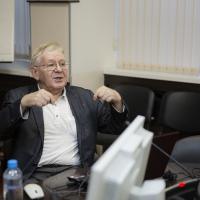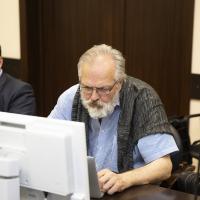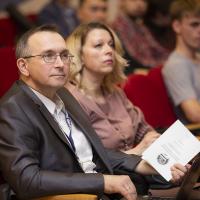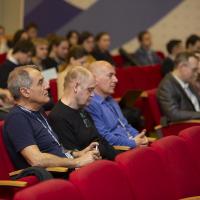From 16th to 21st April MEPhI has hosted the VII International youth scientific school-conference "Modern problems of physics and technology" where young scientists discussed topical issues of modern fundamental and applied physics as well as nuclear and physical technologies.
The school-conference was attended by about 300 young scientists from Russian and foreign universities, including 120 from MEPhI. The main purpose of the school-conference was to attract talented young people engaged in scientific research in the field of laser and nuclear physics to the University.
“In the days of the school, we organized lectures by well-known Russian and foreign scientists, who teaches at MEPhI, acquainted the youth with interesting areas of research so that students, who come to us from other universities, want to study in the master course,” said the Director of Engineering Institute of Engeneering Physics for Biomedicine at the National Research Nuclear University MEPhI Irina Zavestovskaya.
The researches, presented within the framework of the forum, were thematically consistent with the directions of the main research institutes of MEPhI. These are nuclear physics and technologies, laser physics and plasma physics, engineering and physical technologies for biomedicine, intellectual and cybernetic systems, electronics and nanotechnology, Irina Zavestovskaya noted.
During the conference we talked with some speakers and asked questions based on their statements.
Professor of the Macquarie University (Australia) and MEPhI Andrey Zvyagin spoke about the development in the sphere of "cancer nanotechnology".
- Why did you decide to use nanotechnology for cancer treatment?
- The use of nanotechnology for cancer treatment provides additional benefits for the delivery of cancer drugs, also it can significantly reduce the side effects associated with the accumulation of cancer drugs in healthy cells, tissues and poisoning the entire body. In this respect nanoparticles are very effective: they really allow to get rid of it. As I said, they can serve as more effective means of delivery. That means they can be loaded with a lot more “therapeutic cargo”, as we call it, and deliver it. In the light of new trends in cancer therapy, this type of carriers, "vehicles", are very effective. Also, they can be well visualized in contrast to molecules due to the fact that the engineering of nanoparticles is at a fairly high level. That is why we are able to meet the most demanding requirements that we can receive from clinics.
- Is it possible to use nanotechnology to detect cancer at an early stage?
- Nanotechnologies can be used as an analytical tool. This is already being done, for example, genome sequencing, making it possible to detect the tendency to the formation of the tumor. You can do minimally invasive monitoring. The procedure uses particles that are floating diagnostic platforms. The procedure consists of a small blood collection, the results of which can be analyzed very quickly. It is such a rapid test that can report that a person has problems. This is used as an analytical tool. Nanotechnologies can be used as a means of early diagnosis, but the question in the economy: how appropriate it is and how people are willing to undergo this procedure, for example, to make an annual "screening" or other diagnosis.
- What are the caveats for using nanotechnology to treat cancer?
- First of all, it is the cost. It's a new thing, so it's expensive. If we talk about a wide application, it is necessary to monitor the toxicity associated with the accumulation, primarily in the liver and spleen, more closely. These organs are filters of foreign material, including nanoparticles, which leads to its accumulation in these organs. If the non-toxicity of nanomaterials for these organs is well studied and properly monitored, then I do not see any particular problems here. However, even using such a bioinert nanoparticles as nanogold, it should be borne in mind that it is insoluble and tends to accumulate, for example, in the liver for a long period, measured in months. Since we cannot predict the consequences of such a long presence of insoluble nanomaterials in the body, it worries. In the rapidly developing scientific field of oncology, the following approach to the engineering of nanomaterials receives more recognition: nanomaterials should leave a body, fulfilling its target task, for example, dissolved in a biological environment. We are working on this, including with the PhysBio research team. I hope to talk about developments in this direction at the next school-conference.
- How long do you think it will take to test the drug on a person?
- The question is good, but it is painful and stressful for us, because the test cycle from scientific development to its serial production is long: pre-clinical animal testing, and then clinical trial takes place in four phases. If it goes well, even perfectly, it takes ten years. However, as you know, most of such pharmaceutical developments do not live up to this happy ten-year milestone; something turns out to be wrong: either efficiency or economic unattractiveness, or they turn out to be toxic. Now the main rule is “Do not harm”. Of course, the effectiveness of a tool is of great importance, but "do not harm" in this case is the primary rule. Ten years is the amount of time I can claim. Now we've gone through a preclinical phase in testing nanomaterials that have a chance of being registered as pharmaceuticals, but if we want to change anything in our particles, we will have to go all the way again. I hope that in ten years we will see each other and I will be able to present the result.
The employee of a research laboratory of molecular beam epitaxy and nanolithography Yuri Sibirmovsky gave more information about his report and how quantum computers will differ from the usual ones.
- What is the uniqueness of your report?
- My report is devoted to the topic of my future dissertation. A large amount of work has been done by our group in the field of creation and research of gallium arsenide rings. These are nanostructures, which are similar to quantum dots, but have central holes, so that they have special properties in the magnetic field, some other electronic optical properties also differы from the properties of quantum dots. Such objects can be used in optoelectronics to create photodetectors or solar cells and in more "exotic" applications, such as quantum computers.
- How are these rings made?
- There is a method of drip epitaxy, it's like a normal molecular beam epitaxy, when we precipitate different substances and get crystalline layers on the substrate in high vacuum. However, the difference is that in this case we alternately precipitate, for example, gallium and arsenic: gallium forms nanoscale droplets on the surface, after which we anneal a sample in the flow of arsenic and various processes lead to the formation of nanostructures of complex shape: these can be rings, or even double concentric rings, paired quantum dots and many other objects. My work was to identify the mechanisms of formation of these structures, to learn how growth conditions affect their shape, size and other parameters and to study their optical and electronic properties in order to use them for instrument applications in the future.
- What are the advantages of a quantum computer compared to a conventional computer?
- A quantum computer instead of a bit, where there are states of zero or one, has a so-called "quantum bit" or "qubit" with, as it is called in quantum physics, "superposition" of states, overlay, simultaneous state of both zero and one with some probabilities. This means that we must somehow read this state without the wave function collapsing. Usually, if we measure a quantum system, it immediately turns into one of the quantum states - it is the main difficulty. Quantum computers will perform parallel calculations most effectively, so they are still being studied. If you receive a quantum computer consisting of hundreds of steadily interacting qubits, the capabilities of such a computer will surpass conventional computers, even the most modern.

























